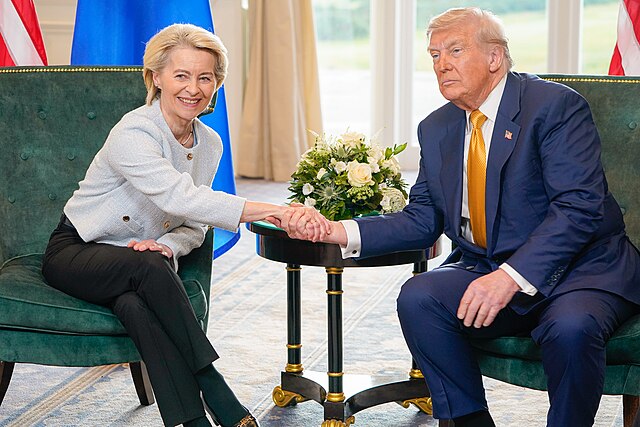As you may have heard, the EU and US have struck a trade deal—sort of.
In case you missed it, in Scotland earlier this week, European Commission President Ursula von der Leyen and President Trump announced a trade agreement reshaping the $2T transatlantic trade relationship, including a blanket 15% tariff on all European goods imported to the US.
But here’s the kicker: According to Trump, Europe will also be buying “vast amounts” of US military equipment worth “hundreds of billions.” One issue: it’s less of a done-and-dusted deal and more of a vibe.
Broken promises: The White House’s announcement stated that the EU “agreed to purchase significant amounts of U.S. military equipment.” According to the EU, however, “Arms procurement is not a matter for the Commission,” as one senior official told reporters on Monday. The “hundreds of billions” figure was “more an expression of expectation on the part of President Trump that the increased defense expenditure would benefit US defense companies,” but “it was not calculated in any way into the figures we talked about.”
Sounds like we’re all on the same page.
While Ursula von der Leyen didn’t mention US military purchases in her announcement, and most analysts expect EU firms to be the primary beneficiaries of big defense budgets, the idea of “hundreds of billions” going to US firms rattled the EU’s defense sector. After the announcement, shares of France’s Thales fell 4.3%; Germany’s Renk and Rheinmetall dropped 5.1% and 3.3% respectively; and Italy’s Leonardo sank 0.74%.
The trade deal-ish aside, the recent big-time boost in EU defense spending is–in all likelihood–going to benefit US defense companies.
- In the European Commission’s 2024 report on EU competitiveness, former Italian PM and European Central Bank President Mario Draghi noted that 78% of EU defense spending on procurement from 2022 to 2023 went outside the bloc.
- Of that, 63% went to US companies, especially the ones cranking out big-budget goodies—F-35s, Patriots, all those crowd favorites.
- Draghi said this disparity “may be justified in some cases because the EU does not have some products in its catalogue,” but “in many other cases a European equivalent exists, or could be rapidly made available.”
Vibe shift: As we’ve seen in the past, well, seven months, there has been a big effort to make those European alternatives available–and fast.
Germany, the EU’s biggest economy, promised this week to double its annual defense budget to as much as €162B ($189B) by 2029. Nothing gets the ball rolling quite like your strongest military ally suggesting your biggest threat “can do whatever the hell they want.”
But not all hope is lost for those US firms angling for European business. Capital Alpha Partners, an equity research firm, noted in a report this week that “US-European defense trade will be sustained and there will remain some areas of opportunity for US firms to provide equipment that can be delivered before Europe develops more of its own, and/or because there is capacity in the US.”
And as the European Commissioner for Defence and Space, Andrius Kubilius, told Tectonic and other reporters in DC at a recent roundtable, “We can incentivize [members] to spend more on European products” and “we want our defense industry to become stronger,” but member states are free to spend their cash where they want.
“It’s very important for us to take responsibility for European defense, especially in areas where we are now very dependent upon America,” he added.
That may be a good call for Europe, particularly since, as Kubilius acutely observed, “We are living in times where predictability is not advertised.”

